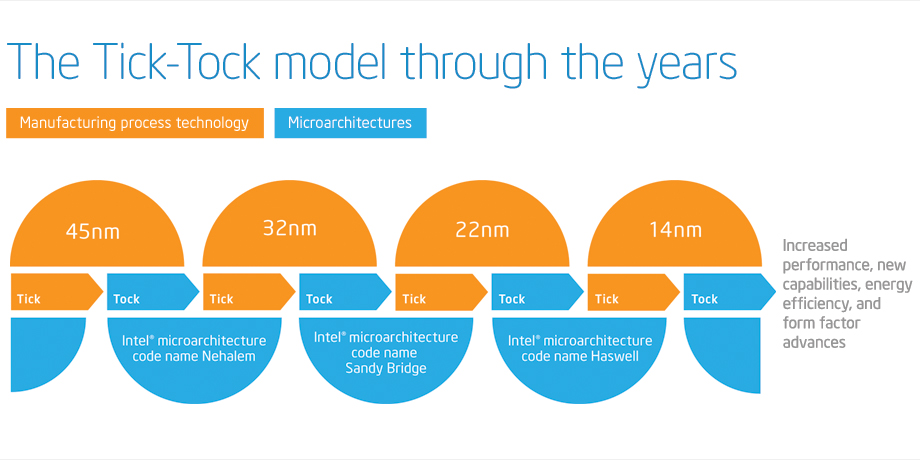Intel releases a new processor microarchitecture every two years, which is called a Tock release. One year later, they take that same microarchitecture and move it to a new, smaller manufacturing process, along with adding some minor feature improvements. This is called a Tick release. Table 1 shows the recent and upcoming Tick-Tock releases.
| Process Size | Code Name | Release Type |
| 45nm | Nehalem | Tock |
| 32nm | Westmere | Tick |
| 32nm | Sandy Bridge | Tock |
| 22nm | Ivy Bridge | Tick |
| 22nm | Haswell | Tock |
| 14nm | Rockwell | Tick |
Table 1: Tick-Tock Release Milestones
Figure 1 shows the Tick-Tock release relationship, with the Tocks in blue and the Ticks in orange.

Figure 1: Tick-Tock Model
The next major Tock processor release from Intel will be Haswell. Haswell is the next Tock release after Sandy Bridge. Haswell is supposed to be released for the desktop and mobile space in the March-June 2013 time-frame. Based on past experience, that probably means that we will see the server oriented Haswell-EP and Haswell-EN server microprocessors show up one to two quarters later in 2013.
According to various Intel roadmap slides that have been leaked, Haswell-EP will have 10-14 CPU cores, with 2.5MB of L3 cache per each core, for a total of up to 35MB of shared L3 cache for the entire processor. The Haswell-EP processors will also have a quad-channel DDR4 memory controller, supporting transfer speeds 1333, 1600, 1866 and 2133 MT/s. They will also have two quick path interconnect (QPI) channels, and PCI Express 3.0 with 40 lanes on Haswell-EP, and 24 lanes on Haswell-EN. They will also support Hyper-Threading and Turbo Boost.
If this is true, you could see up to 28 physical cores or 56 logical cores in a two socket server with Haswell-EP. If Intel continues what they started with Sandy Bridge-EP, there will also be a four socket version of Haswell-EP that would have 56 physical cores or 112 logical cores in a commodity four socket server by late 2013!
Since Haswell is a Tock release, we can expect a big performance boost over Sandy Bridge. Historically, Tock releases have shown anywhere from a 50-100% performance increase for various workload types. Haswell requires a new processor socket and different chipset, so the server vendors will have to release new model servers (for example a Dell PowerEdge R730) to accommodate it. This is pretty exciting stuff!
Filed under: Computer Hardware, Haswell, Intel, Processors Tagged: Haswell-EP, Tick-Tock
![]()


